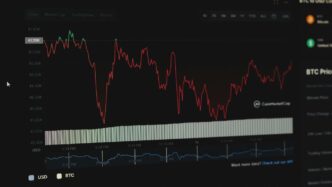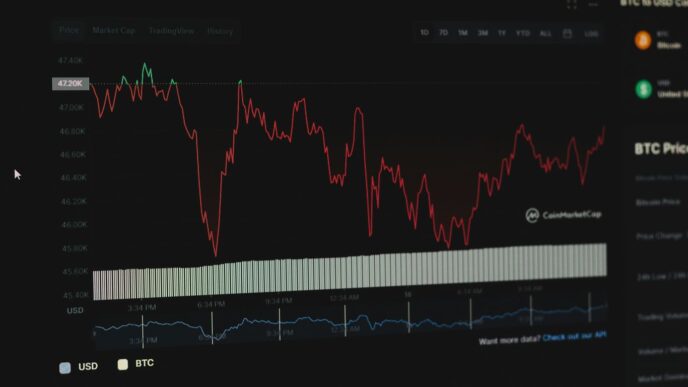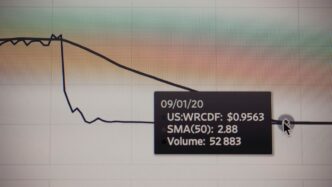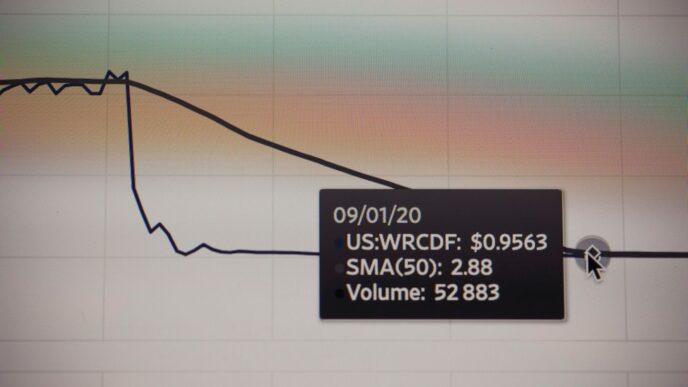Coinbase stock has been on a wild ride lately, and a lot of folks are asking, “why is Coinbase stock down?” After some big gains earlier in the year, the stock took a sharp turn south following its latest earnings report. There are quite a few reasons for this drop, from disappointing financial results to outside market pressures. If you’re scratching your head about what’s going on, you’re definitely not alone. Let’s break down the main things pulling Coinbase shares lower in 2025.
Key Takeaways
- Coinbase missed Wall Street’s expectations for both earnings and revenue, with transaction income dropping sharply from the previous quarter.
- Trading activity slowed down for both regular users and big institutions, which meant less money coming in from fees.
- Operating costs, including hiring and marketing, went up a lot, squeezing profits even though overall revenue grew.
- Big-picture issues like a weak stock market, new trade tariffs, and shaky crypto prices made investors nervous.
- Analyst downgrades, plus changing laws and regulations around crypto, have added even more uncertainty for Coinbase’s future.
Disappointing Financial Results Trigger Investor Concern

Sometimes, it doesn’t really matter how much you hype up a product or a stock—if the numbers don’t show up, the market reacts, and not always in your favor. Let’s break down why a lot of investors are eyeing Coinbase with suspicion in 2025, starting with their recent results.
Earnings and Revenue Miss Wall Street Expectations
Coinbase fell short of both revenue and earnings targets for the latest quarters, surprising many on Wall Street. Here’s a quick summary of the first-quarter numbers:
| Metric | Q1 2025 | Q1 2024 | Expectations |
|---|---|---|---|
| Earnings per Share (EPS) | $0.24 | $4.40 | $2.09 |
| Revenue | $2.03 billion | $1.64 billion | $2.1 billion |
| Net Income | $66 million | $1.18 billion | — |
Revenue still grew 24% compared to last year, but because it didn’t live up to predictions, the stock took a hit. The earnings drop—from $4.40 a share last year to just $0.24—looked especially rough next to past performances.
Sharp Decline in Transaction Revenue
The biggest gut punch actually came from a sharp drop in transaction revenue, which had been a major profit engine for Coinbase:
- Transaction revenue was $1.3 billion, up a bit from last year, but down 19% from the previous quarter.
- Institutional trading volume fell 9%, and consumer trading dropped 17%, which stung because these two groups together drive most of Coinbase’s trades.
- The slowdown really set in after the wild start of the year, especially once crypto prices dipped in the spring and volatility made regular traders a bit more cautious.
A lot of this decline in revenue seemed to trace back to things like lower fee rates and extra incentives to keep users active. For more on trading volume and how it fluctuates with crypto prices—sometimes leading to sudden Coinbase stock surges—take a look at recent market trends.
Weaker Outlook for Subscription Services
Subscription and services revenue was actually up 9% from the previous quarter, climbing to $698 million. But even here, investors weren’t exactly thrilled:
- Growth was driven by stablecoins, mainly because of a huge increase in USD Coin (USDC) balances.
- Other services like staking and custodial offerings did grow, but the company’s guidance suggested that the wild pace of growth seen last year probably wouldn’t continue.
- Analysts pointed out that as trading activity cools and fee revenue drops, Coinbase will need even more from these steadier subscription streams to offset the loss.
Overall, the mood after the results came out was more cautious than excited. When expectations get baked in—and are then missed—stocks like Coinbase tend to tumble. If the company can’t beat the Street next quarter, even more pressure could pile on.
Reduced Trading Activity and Volume Pressures
Trading activity at Coinbase has been under strain lately, and you can really see that in how its numbers stack up this year. Even though some headline figures look decent, there are real issues bubbling beneath the surface. Let’s break it down.
Institutional and Consumer Trading Volumes Decline
Institutional trading—the big money stuff—dropped 9% from the previous quarter, while consumer or retail trading slowed down by 17%. This isn’t just a blip, either. Over recent quarters, both groups have scaled back, though institutional pullback hurt more since those trades tend to be larger. For comparison:
| Segment | Q1 2025 Volume | % Change vs Q4 2024 |
|---|---|---|
| Institutional | $315 billion | -9% |
| Consumer | Not disclosed | -17% |
Why the slowdown? A mix of crypto price swings, bigger players looking elsewhere, and some just sitting on the sidelines. That uncertainty filters down, so fewer people are willing to jump in and trade.
Lower Fee Rates and Increased Incentives Impact Revenue
Coinbase is also earning less from each trade than before. As trading cooled off, they rolled out extra incentives and lower fees to try to get folks trading again. The result? Revenue per transaction slipped. Here’s why that hurts:
- Coinbase’s main source of income comes straight from transaction fees.
- Lower fee rates mean they need much more activity just to stay even.
- Incentives can attract new trades, but usually shrink margins in the process.
In short, more trades don’t always mean more money if each one pays less.
Market Volatility Drives Retail Behavior
Volatility isn’t always good for exchanges. Sharp moves in prices sometimes scare off everyday users, who might decide to wait things out instead of jumping into fast swings. In early 2025, crypto prices fell, triggering bursts of activity, followed by long lulls. That led to:
- Sudden spikes of trading, but followed by slow periods where nobody wanted to touch risky coins.
- Shifting focus from trading to holding, especially after quick losses.
- More users hopping between platforms looking for the best fee or reward deals.
So, with trading volumes dropping, fee pressure mounting, and retail users getting more cautious, it’s no surprise that revenue ended up missing the mark. Coinbase is feeling the squeeze—lower activity levels, fee competition, and jumpy customers all add up quickly.
Rising Costs Weigh on Profitability
Surge in Operating Expenses and Headcount
Running a major crypto platform isn’t cheap, and Coinbase’s costs are showing it this year. Operating expenses have shot up, cutting into profitability even as the business grows. Payroll keeps climbing as Coinbase hires more staff to handle everything from tech support to compliance. In the first quarter of 2025 alone, total expenses jumped over 50% year-over-year, fueled by:
- More employees joining the team
- Growing payroll taxes and benefits
- Extra administrative costs to stay ahead of regulatory changes
| Category | Q1 2024 | Q1 2025 | % Change |
|---|---|---|---|
| Operating Expenses | $870M | $1.32B | +51.5% |
| Net Income | $1.18B | $66M | -94.4% |
| Headcount | ~4,000 | ~5,200 | +30% |
Increased Marketing and Expansion Spending
Coinbase isn’t just running in place—it’s chasing growth around the globe and that costs money. This year, the company is:
- Upping its marketing budget to draw in new users, expecting up to $375 million in spend for the next quarter
- Expanding internationally, which includes local launches and compliance efforts that take real cash
- Investing in new tech and features, hoping to keep existing users sticking around
All this extra spending should, in theory, help the company grow, but in the short term it adds pressure to the bottom line.
Squeezed Margins Despite Revenue Growth
Here’s where it gets tough: even with rising revenue, margins are under serious pressure. Adjusted EBITDA dropped over 8% year-over-year in early 2025—not catastrophic, but a trend that’s worried a lot of investors. The margin squeeze mostly comes down to:
- Bigger payrolls and tech investments outpacing income growth
- More money poured into marketing and expansion
- Fee pressures and trading incentives making every dollar a bit harder to earn
| Financial Metric | Q1 2024 | Q1 2025 | % Change |
|---|---|---|---|
| Revenue | $1.64B | $2.03B | +24% |
| Adjusted EBITDA | $1.01B | $930M | -8.3% |
| EBITDA Margin | 61.6% | 45.8% | -25.6% |
At the end of the day, rising costs are starting to bite. If Coinbase can’t keep its expenses from running wild, even solid revenue growth might not be enough to keep investors happy.
Market and Macroeconomic Factors Influence Sentiment
A lot of what happens to Coinbase’s stock isn’t just about the company itself—what’s happening out in the wider economy and on the trading floors matters, too. There’s been a mix of shaky economic news, market swings, and a bunch of macro factors pulling at investor confidence. Here’s where things really stick out:
Broader Stock Market Weakness and Uncertainty
The entire market has been on edge lately, and tech stocks—especially those linked to crypto—tend to feel every bump. After the latest jobs report came out weaker than expected and new trade tariffs popped up, a lot of folks started pulling out of riskier assets like Coinbase. It’s a pretty normal reaction: when people worry about the economy, the first thing they often do is trim anything seen as speculative. You could almost see the domino effect as big drops in the main indexes triggered even sharper declines for individual names.
Impact of U.S. Jobs Data and Trade Tariffs
Recent data has been messy:
- U.S. jobs numbers came in below forecasts yet again (for the third month in a row).
- New tariffs were announced, raising concerns about an economic slowdown and higher costs across industries.
- Traders started pricing in the chance of another interest rate hike, which always makes people rethink growth stocks that don’t pay dividends.
| Economic Factor | Recent Status | Likely Impact on COIN |
|---|---|---|
| Jobs Report | Missed expectations | Lower risk appetite |
| Trade Tariffs | Announced/increase | Higher uncertainty |
| Interest Rate Hike Chances | Increased | Lower stock valuations |
When these sorts of numbers hit, the knock-on effect is usually a dip in trading volume and fewer retail investors willing to try their hand at crypto.
Heightened Volatility in Crypto Asset Prices
It’s not just stocks people are watching—crypto prices have been jumping all over the place. Bitcoin had a huge rally in early summer but then tumbled after the regulatory news cooled off. Ethereum and other coins followed. When crypto prices become unstable, a few things tend to happen:
- Retail investors, especially first-timers, often pull back to avoid losses.
- Trading activity on platforms like Coinbase slows, shrinking fee revenue.
- Hedge funds and institutions sometimes pause or reduce their exposure, waiting for things to calm down.
Markets thrive on confidence, and right now that confidence feels pretty low, thanks to the wild swings in coin prices and all the other bad macro news. That’s why you’ll see Coinbase shares moving even when the company itself isn’t making any big announcements—investors are reacting to the bigger picture as much as to earnings or partnerships.
Regulatory Developments Add Complexity
Sometimes, new rules feel like they should clear things up. But with crypto, especially for Coinbase, regulation seems to just make the landscape bumpier and more dramatic. Here’s what’s been happening lately and why investors are still cautious.
Shift Towards Clearer Crypto Legislation
Lawmakers have finally started pushing for more explicit crypto laws, but for every small win, there’s new uncertainty.
- The GENIUS Act, focusing on stablecoin regulation, was both celebrated and then quickly blocked, leaving the industry in limbo yet again.
- While Coinbase cheered recent movement in Congress, it’s impossible to say how soon any real, permanent framework takes hold.
- Anticipation is high that pro-crypto lawmakers—backed by a friendly White House—might try again, but if you’re watching the stock, it doesn’t offer much near-term comfort.
White House and Congressional Influences
With President Trump vocal about wanting to see the U.S. lead in crypto innovation, you’d think companies like Coinbase would get a boost. But politics can swing fast:
- Trump’s backing is seen as positive—but it changes quickly if Congress doesn’t follow through.
- The signs look good for more pro-crypto policies, yet until laws get passed, it’s all just talk.
- Many on Wall Street are waiting to see if the White House can actually influence Congress or if real change gets lost in the shuffle.
SEC Lawsuit Dismissal and Legal Wins
Coinbase got a rare bit of good news with a major SEC lawsuit against it being dismissed:
| Event | Date | Effect on COIN Stock |
|---|---|---|
| SEC lawsuit filed | Feb 2024 | Sharp sell-off |
| White House signals crypto reform | May 2025 | Brief buying rally |
| SEC case dismissed | Aug 2025 | Temporary price uptick |
- Investors liked the dismissal at first. Shares bounced, but the celebration was short-lived as the broader market focus shifted back to legislative gridlock.
- Legal fights like this mean costs add up while the company waits for true clarity on what it can, and cannot, legally do.
In short, regulatory news has been a rollercoaster this year. Even the wins don’t feel all that solid—just ask anyone who bought COIN at the peak this summer. Until new laws stick for good, investors are probably going to keep getting whiplash from headlines.
Analyst Ratings and Institutional Moves Affect the Stock
Stock moves as much on what the money pros think as on what the company itself does. Coinbase is a good example: the past few months saw a real back-and-forth between optimism and caution from analysts, with every earnings report and regulatory headline sparking a new round of reassessment.
Target Cuts and Downgrades from Major Banks
Right after Coinbase posted weaker-than-expected quarterly numbers, major banks cut their price targets and some even issued downgrades. Barclays trimmed its target, and Monness Crespi & Hardt gave the stock a downgrade. These calls weren’t out of nowhere—transaction revenue tumbled 39%, which spooked analysts looking for stronger growth. At the same time, banks like Citi bucked the negative trend, boosting their target all the way to $505 from $270 as hopes built that new legislation could push crypto trading higher. Here’s a look at some recent changes:
| Analyst | Previous Target | New Target | Reason for Change |
|---|---|---|---|
| Barclays | $350 | $300 | Lower transaction revenue |
| Citi | $270 | $505 | Positive regulatory trend |
| Monness Crespi | $320 | $275 | Momentum slowing |
This mix of upgrades and downgrades created some choppy trading, with investors often reacting quickly to each headline.
Inclusion in the S&P 500 and Index Effects
When Coinbase got added to the S&P 500, it was a big deal. It’s the first crypto-focused company to make the cut. As soon as the news hit, the stock jumped since index-tracking funds had to buy shares. Institutional interest began picking up, too: these large investors generally follow indexes for portfolio allocations, so joining the S&P meant more money flowing in. Over time, this usually provides a more stable, even if sometimes slowly rising, base of demand. It also means any wild moves in price get a bit sanded down as more long-term holders step in. For more on how recent Coinbase revenue trends shaped expectations, see recent earnings data.
Here are a few effects from the S&P inclusion:
- Immediate buying pressure as index funds add the stock
- Potential for reduced volatility due to broader ownership
- Greater legitimacy with traditional finance players
Bullish and Bearish Analyst Perspectives on Momentum
There’s honestly been little consensus on where Coinbase is headed next. Some analysts remain upbeat:
- Regulatory wins and clear laws for stablecoins could unlock more growth
- Adoption of new features (like reward point transfers and credit card funding with JPMorgan Chase) adds new users
- Exposure to the entire rising tide of cryptocurrency, not just Bitcoin
But plenty are sounding the alarm:
- Slower-than-hoped trading activity is hurting fees
- Volatility in crypto prices makes forecasting tricky
- After a rapid run-up, some see a classic case of too much, too fast
If you’re following analyst sentiment, expect more fireworks with every earnings update and policy shift for a while. Right now, the swing back and forth means you’ll see sharp price moves as analysts and institutional investors try to get ahead of the story—and sometimes, that happens quarter to quarter, not just year to year.
Strategic Partnerships and Acquisitions Shape Outlook

When it comes to Coinbase, you can really see how much they count on strategic deals and big buyouts to guide their future—especially this year. Every time they announce a major acquisition or collaborate with a large bank, you can almost feel the shockwave through the market. Let’s look at three partnerships and moves making headlines, and how they might affect Coinbase’s story in the months to come.
Collaboration with JPMorgan Chase
Coinbase surprised the market just days ago with a new partnership with JPMorgan Chase. This isn’t just a headline—there are new features set to roll out for anyone banking with Chase:
- Chase users will soon have a direct bank-to-wallet connection, making crypto purchases much easier.
- They’ll be able to transfer Chase Ultimate Rewards points directly into Coinbase, where 100 points will equal $1.
- Chase credit cards are in the works for funding Coinbase accounts, with a rollout slotted for fall 2025.
The buzz from investors is mostly positive. Many see this as making crypto much more accessible for average Americans, and it’s a stark change from the days when banks and crypto companies acted more like distant rivals than potential partners (announcement of the new iPager).
Acquisition of Deribit for Derivatives Expansion
The announcement that Coinbase is buying Deribit for $2.9 billion made waves this summer. If you haven’t heard of Deribit, it’s the top name in global crypto derivatives:
| Metric | Deribit Stats |
|---|---|
| Annual Trading Volume | $1 trillion |
| Open Interest | $30 billion |
| Industry Focus | Crypto Options |
With this move, Coinbase goes from a newcomer to a top player in crypto options and futures. This isn’t just an expensive shopping spree—the idea is to pull more institutional clients into Coinbase and to capture the next wave of revenue coming from outside the United States. This deal could give them a firmer grip on a major (and growing) part of the crypto universe, though it likely brings new risks as well.
Diversification into Stablecoins and Service Revenues
Lately, Coinbase is hinting at broadening its base, and stablecoins play a key role. So far, there’s a short list of ways this strategy stands out:
- Launching new products based around stablecoins, aimed at both businesses and everyday users.
- Attracting traditional financial firms who want to use stablecoins, but aren’t ready to build their own tech.
- Collecting steady service fees from these new ventures, rather than relying just on trading commissions and wild crypto swings.
Regulatory moves in Washington might be a tailwind for this area—pending legislation around stablecoins could help, and Coinbase hopes to take advantage if the right bills pass in Congress later this year.
In the end, all these partnerships and buyouts don’t guarantee smooth sailing, but they do show Coinbase is taking some big risks to grow beyond its roots. If these bets pay off, they might help balance out the rocky parts of the business. If not, well, shareholders are in for a bumpy ride.
Conclusion
So, that’s the story with Coinbase stock lately. The company has had a rough patch, missing earnings and revenue targets, and that spooked investors. Trading activity dropped, especially among big institutions, and expenses are climbing as Coinbase tries to grow. Add in some shaky economic news and new tariffs, and it’s no surprise the stock took a hit. Still, there are some bright spots, like growing subscription revenue and new partnerships that could pay off down the road. The crypto world is always changing, and Coinbase is right in the middle of it. If you’re thinking about investing, it’s worth keeping an eye on how the company handles these ups and downs. Things could turn around if the market gets more stable or if new regulations make things clearer for everyone.
Frequently Asked Questions
Why did Coinbase stock drop recently in 2025?
Coinbase stock fell because the company reported lower earnings and revenue than experts expected. There was also a big drop in trading activity, especially from large investors, and the company shared a weaker outlook for its subscription services.
How did Coinbase’s financial results compare to last year?
Coinbase’s revenue grew 24% from last year, but it still missed Wall Street’s predictions. Net income and earnings per share dropped a lot compared to the previous year, showing that the company is making less money per share.
What other factors besides earnings caused the stock to fall?
Besides earnings, the stock was affected by a weaker stock market, new U.S. trade tariffs, and a poor jobs report. These things made investors nervous and led to more selling.
Is Coinbase still growing in other areas?
Yes, Coinbase is still growing its subscription and services income, especially from stablecoins like USDC. The company is also expanding by buying Deribit, a big crypto derivatives exchange, and working with JPMorgan Chase to reach more customers.
What role do regulations play in Coinbase’s stock price?
Regulations have a big impact on Coinbase. Changes in crypto laws and court cases, like the SEC lawsuit being dismissed, can either help or hurt the stock. Investors are watching for clearer rules that could help the company in the future.
Are analysts still positive about Coinbase?
Some analysts have lowered their price targets or ratings after the earnings miss, but others remain hopeful because of new partnerships, growing service revenue, and the company joining the S&P 500 index. This means opinions are mixed, but some experts still see long-term potential.














